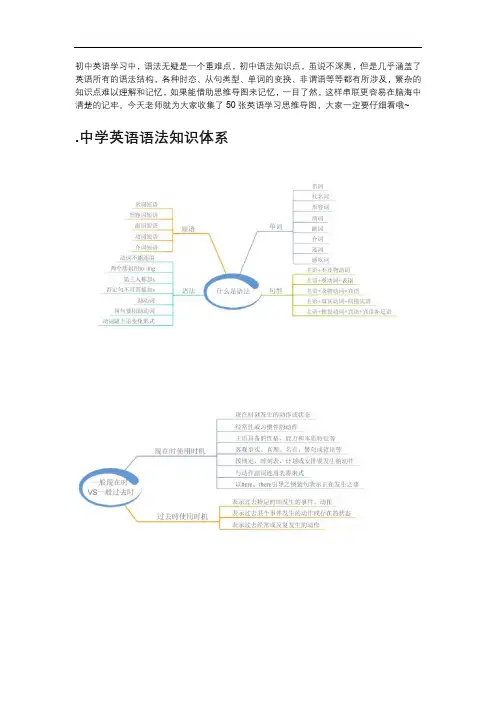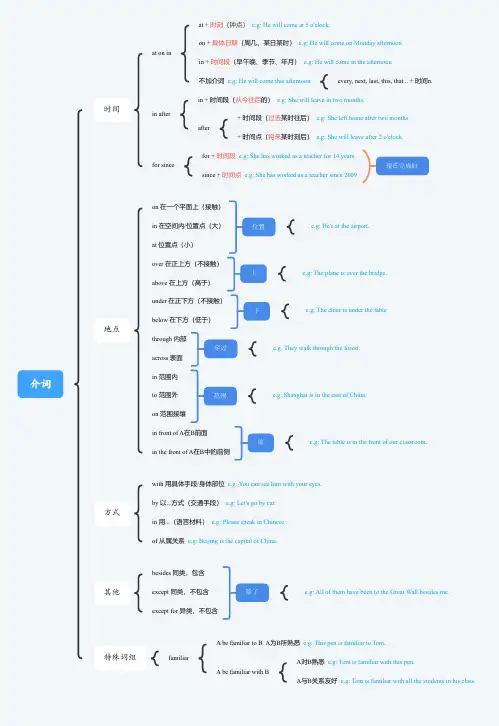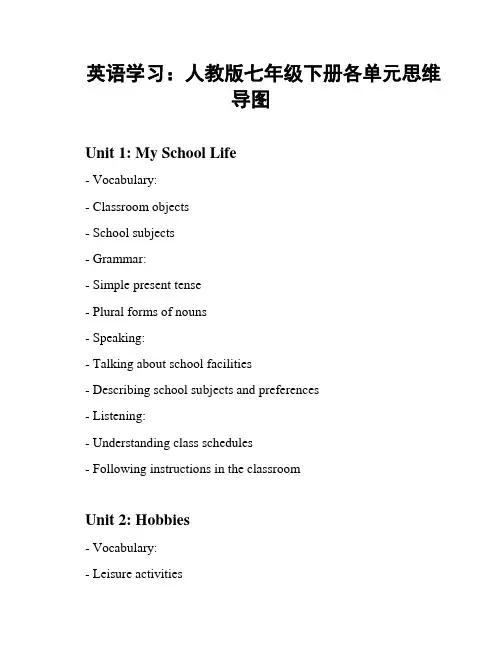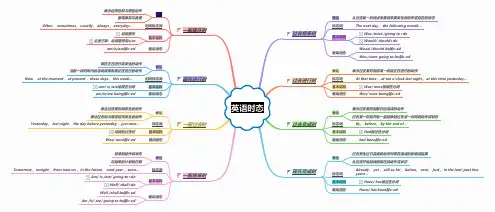初中英语考点思维导图
思维导图破解初中英语语法:动词(PPT讲解)

动词知识点导图系动词1细节图:
动词知识点导图系动词2细节图:
动词知识点导图情态动词1细节图:
动词知识点导图情态动词2细节图:
动词知识点导图情态动词3细节图:
动词知识点 总导图
PART 2
利用知识点导图来解题
此部分务必观看视频讲解
Use mindmaps to solve questions
have had a good time.示对过去事情否定的推测。can‘t have done意为“不可能做...“; shouldn’t have done表示对某事的责备和批评,意为“本不该做却做了”;B、D都表示 肯定的推测,由It rained a lot during their jouney可知意义不对。
初中英语高效学习
答案2
D,句意:我想给鲍勃打个电话,应该的,你很长时间没与他联系了。will 意为“将 要”,表意愿;have to意为“不得不”(外力强迫);根据后句“很长时间没与他联系了” 可推知,应选“应该",故选D。
例题3
It rained a lot during their journey, so they A. can't B. must C. shouldn't D. might
D. mustn't
初中英语高效学习
答案1
B,句意:我们或许不能证实我们是伟大的探险家,但我们确实进行了十年来最伟大的 长征。needn‘t 意为“没必要”; shouldn’t 意为“不应该” ; mustn‘t意为“禁止”;均不合 题意,may not意为“可能不”符合题意。
例题2
一I think I'll give Bob a ring. 一You , You haven't been in touch with him for ages. A. will B. may C. have to D. should
思维导图破解初中英语语法:从句(PPT讲解)

Thank you
从句知识点导图定语从句细节图:
从句知识点导图定语从句细节图:
从句知识点导图状语从句1细节图:
初中英语高效学习
从句知识点导图状语从句2细节图:
初中英语高效学习
从句知识点导图总导图:
PART 2
利用知识点导图来解题
此部分务必观看视频讲解
Use mindmaps to solve questions
初中英语高效学习
例题1
The way he did it was different A. in which B. in what C. from what D. from which
we were used to.
初中英语高效学习
答案1
C,句意:他做这件事的方法同我们所习惯的不同。根据句子结构可知,词组be different from后跟的是宾语从句,而这个宾语从句缺少宾语,所以用引导词what, 意为“我们以前所习惯的那种方式”from后跟的不是定语从句,因此不要误选D; different 不能与in搭配,故排除A和B。
初中英语高效学习
例题3
The poor young man is ready to accept A. whichever B. however C. whatever D. whenever
help he can get.
初中英语高效学习
答案3
C,本题考查宾语从句的用法。由句式结构可知,此处及物动词accept缺宾语,所以后 面的应该是宾语从句。在宾语从句中,及物动词get缺宾语。所以空格处应填入一个既 可引导宾语从句、又可以在宾语从句中作宾语的词,B、D不能引导宾语从句; A项可以 引导宾语从句,但是它表示在一定范围内的选择,故不符合句意。由题意可知C项为正 确答案。
初中英语思维导图大全

初中英语学习中,语法无疑是一个重难点,初中语法知识点,虽说不深奥,但是几乎涵盖了英语所有的语法结构,各种时态、从句类型、单词的变换、非谓语等等都有所涉及,繁杂的知识点难以理解和记忆,如果能借助思维导图来记忆,一目了然,这样串联更容易在脑海中清楚的记牢。
今天老师就为大家收集了50张英语学习思维导图,大家一定要仔细看哦~.中学英语语法知识体系2.英语能力树3. 英语学习习惯4. 单词记忆通用工具5. 英语整体建构课堂教学模式6. “和谐教育整体建构教学法”7. 中学英语16种时态8. 名词I9. 名词II10. 冠词11. 数词12. 代词的分类13. 人称代词14. 物主代词15. 反身代词16.指示代词17. 疑问代词18. 关系代词19.不定代词20. 形容词21. 副词22.形容词和副词的比较等级23. 有关比较级的区别24. 动词25. 常见助动词用法26. 助动词27. 非谓语动词28. 动词ing形式29. 不定式的时态和语态30. 省to 的动词不定式31. 不定式作宾语32. 不定式作补语33. 不定式作主语34. 不定式句法功能35. doing与to do的区别136. doing与to do的区别237.分词38.独立主格结构39.一般现在时40.一般将来时41.现在完成时42.一般过去时43.现在进行时44.时态与时间状语45. 被动语态46. 各种形式的被动语态47.句子的种类48.反意疑问句49.反意疑问句记忆规则150.反意疑问句记忆规则2。
介词 初中英语语法(思维导图)

介词时间at on inat + 时刻(钟点)e.g: He will come at 5 o'clock.on + 具体日期(周几、某日某时)e.g: He will come on Monday afternoonin +时间段(早午晚、季节、年月) e.g: He will come in the afternoon不加介词e.g: He will come this afternoon every, next, last, this, that... + 时间n.in afterin + 时间段(从今往后的)e.g: She will leave in two months.after+ 时间段(过去某时往后)e.g: She left home after two months.+ 时间点(将来某时刻后)e.g: She will leave after 2 o'clock.for sincefor + 时间段e.g: She has worked as a teacher for 14 years.since + 时间点e.g: She has worked as a teacher since 2009.现在完成时地点on 在一个平面上(接触)in 在空间内/位置点(大)at 位置点(小)over 在正上方(不接触)above 在上方(高于)under 在正下方(不接触)below 在下方(低于)through 内部across 表面in 范围内to 范围外on 范围接壤in front of A在B前面in the front of A在B中的前侧上 e.g: The plane is over the bridge.穿过 e.g: They walk through the forest.下 e.g: The chair is under the table位置 e.g: He's at the airport.范围 e.g: Shanghai is in the east of China.前 e.g: The table is in the front of our classroom.方式with 用具体手段/身体部位e.g: You can see him with your eyes.by 以...方式(交通手段)e.g: Let's go by car.in 用...(语言材料) e.g: Please speak in Chinese.of 从属关系e.g: Beijing is the capital of China.其他besides 同类,包含except 同类,不包含except for 异类,不包含除了 e.g: All of them have been to the Great Wall besides me.特殊词组familiarA be familiar toB A为B所熟悉e.g: This pen is familiar to Tom.A be familiar with BA对B熟悉e.g: Tom is familiar with this pen.A与B关系友好e.g: Tom is familiar with all the students in his class.。
英语学习:人教版七年级下册各单元思维导图

英语学习:人教版七年级下册各单元思维导图Unit 1: My School Life- Vocabulary:- Classroom objects- School subjects- Grammar:- Simple present tense- Plural forms of nouns- Speaking:- Talking about school facilities- Describing school subjects and preferences- Listening:- Understanding class schedules- Following instructions in the classroomUnit 2: Hobbies- Vocabulary:- Leisure activities- Sports and games- Grammar:- Present continuous tense- Adverbs of frequency- Speaking:- Talking about hobbies and interests- Discussing preferences and dislikes- Listening:- Understanding conversations about hobbies- Following instructions for games and activitiesUnit 3: At Home- Vocabulary:- Rooms and furniture- Daily routines- Grammar:- Present simple tense- Prepositions of place- Speaking:- Describing rooms and houses- Talking about daily routines- Listening:- Understanding conversations about household chores - Following instructions for recipes and tasksUnit 4: Food and Drink- Vocabulary:- Types of food and drinks- Quantifiers- Grammar:- Countable and uncountable nouns- How much/How many- Speaking:- Talking about food preferences- Ordering food at a restaurant- Listening:- Understanding conversations about meals and recipes - Following instructions for cooking and servingUnit 5: Family and Friends- Vocabulary:- Family members- Personal pronouns- Grammar:- Possessive adjectives- Wh-questions- Speaking:- Introducing family members- Describing relationships- Listening:- Understanding conversations about family activities- Following instructions for interviews and introductionsUnit 6: At the Zoo- Vocabulary:- Animals and their characteristics- Adjectives to describe animals- Grammar:- There is/are- Speaking:- Talking about animals and their habitats- Listening:- Understanding conversations about zoo visits - Following directions for finding animalsUnit 7: The Weather- Vocabulary:- Weather conditions- Seasons and months- Grammar:- Present continuous for future arrangements - Adjectives to describe weather- Speaking:- Talking about weather in different seasons - Making plans based on weather forecasts- Listening:- Understanding weather reports- Following instructions for outdoor activitiesUnit 8: Holidays- Vocabulary:- Festivals and celebrations- Holiday activities- Grammar:- Past simple tense- Time expressions- Speaking:- Talking about past holidays and celebrations- Describing holiday traditions- Listening:- Understanding conversations about holiday experiences - Following instructions for crafts and gamesUnit 9: Around Town- Vocabulary:- Places in a city- Directions and locations- Grammar:- Imperatives- Giving and following directions- Speaking:- Asking for and giving directions- Describing places in a city- Listening:- Understanding conversations about city attractions - Following directions to different locationsUnit 10: Health and Fitness- Vocabulary:- Body parts and health issues- Sports and exercises- Grammar:- Present continuous for future arrangements- Imperatives for instructions- Speaking:- Talking about health and fitness routines- Giving advice on healthy habits- Listening:- Understanding conversations about health problems - Following instructions for exercises and workouts。
初中英语八大时态思维导图

英语时态一般现在时现在进行时表达表示经常性和习惯性动作客观事实与真理时间标志词Often, sometimes, usually, always ,everyday...表达现在正在进行或发生的动作当前一段时间内的活动或现阶段正在进行的动作时间标志词Now, at the moment ,at present ,these days, this week…基本结构动词原形主语三单:动词原形加s/es基本结构am/ is /are加现在分词一般过去时表达表达过去某时间发生的动作表达过去的习惯或经常发生的动作标志词Yesterday, last night, the day before yesterday ,just now…基本结构动词的过去式一般将来时表达将来的动作和状态对将来的计划和打算标志词Tomorrow, tonight ,from now on ,in the future, next year ,soon…基本结构Am/ is /are/ going to+doWell/ shall+do 现在完成时表达过去发生过已完成的动作对现在造成的影响或结果从过去开始延续到现在的动作或状态标志词Already, yet ,still so far ,before, ever, just ,in the last/ past few years…基本结构Have/ has加过去分词过去完成时表达表示过去某时刻前已经完成的动作过去某一时刻开始一直延伸到过去另一时间的动作或状态标志词By, before, by the end of…基本结构Had加过去分词过去进行时过去将来时表达表示过去某时刻或某一阶段正在进行的动作标志词At that time ,at ten o'clock last night ,at this time yesterday…基本结构Was/ were加现在分词从过去某一时间点来看将来要发生的动作或存在的状态表达标志词The next day, the following month…基本结构Was /were /going to+doWould/ should+do 被动语态am/is/are加v-ed被动语态am/is/are being加v-ed被动语态Was/ ware加v-ed被动语态Well /shall be加v-edAm /is/ are/ going to be加v-ed被动语态Have/ has been加v-ed被动语态had been加v-ed被动语态Was/ were being加v-ed被动语态Wood /should be加v-ed Was /were going to be加v-ed。
初中英语一般过去时思维导图
一般过去时
定义一般过去时表示过去某个时间发生的动作或存在的状态,常和表示
过去的时间状语连用。
结构
1-1:主语(一/二/三复)+did(动词过去式)+其他
2-1:主语(一复/二/三复)+be(were)+其他
2-2:主语(一单/三单)+be(was)+其他
时间标志词
口诀:昨天上个XX前,in+年份when字连
yesterday morning ,last week,in1980,when I was a child…
句型转换
否定句
主语+didn’t +动原+其他/ /
主语+be(was/were)+not +其他
一般疑问句
Did+主语+动原+其他回答:Yes+主语+did./No.+主语+didn’t.
Be(Was/Were)+主语+其他回答:Yes+主语+be./No.+主语+be not.
特殊疑问句
对主语提问:特殊疑问词+did/was/were+其他
对非主语提问:特殊疑问词+did/was/were+主语+其他
特殊考点/
易错点
1.表示过去经常做的事,也
要用一般过去式
I often went fishing with my father when I was a
child.(go)
2. used to do ,
be used to do
be used to doing
的区别
be used to+ doing习惯于做某事
used to + do过去常常做某事
be used to + do 被用于做某事
(be done被动式)。
初中英语最全思维导图英语单词、句型和语法!
。
系动词
,.本属
’ J ,=,;e,E语和农悟之间越i率提功富E的功饲
2.衷语恃性及旬型结构
2.1哥在就Jili!+修军军词 2..2.累鹉饲+like+也铜
3.收恕的改变
l3.1 become, g盹grow
�劫ilil5!e用班补究』苗辈革和搁AA事物的, 常用形容 词来特先说周2锚的不足, 懂得部伺军思蛋,E
’ aSa黛iilli码有两种形疵, -鞠崎彤串串iljJ 1司 形. 一种以-ly捕属 ,
字义习之间
1.使用时机及用法
2.副词的比较组与最高组
+mm 2.1周i!i!l!IJilQ的比茸茸- M
叶’AS
主之比较戴帽曲调的比较→副调比级级+晴、a向
2..3 G,lUlil.刷iSI的I:缸绍卜,罔1怪事事询用能但宋加the
伺
幽布耐『幸 自祸
”
+” 嗣 Z 娓 + 日’aM
制
Mg+非 事
M帽
町 ,刑
别 阳 市
.M
V
M
dwt
N
,..「mWMM“,
NEHWMRE ,,
抽斟圄间目路她 ,,
pmaaHm守,,
u-me
”。响M··
tR
唱
m,
串队串国朋 ,,
EMaE
“ 窜
’TM
将阳 剧 创 F-
公
贵 阳
、”,
筐 嚣响硝
W何’En他
.4.1寄自ii)""莓’ .4.2. 自ll结!ft'>细注:*坦坚
’ .6i乍11:ll诩咂l!.R'J
中考知识要点简记归纳之初中英语思维导图大全
.中学英语语法知识体系3.英 Nhomakorabea学习习惯
9.名 词II
34.不定式句法功能
36. doing与to do的区别2
44.时态与时间状语
46.各种形式的被动语态
49.反意疑问句记忆规则1
人教版八年级上英语各单元主题思维导图课件
初中英语人教版八年级上
Unit3 I’m more outgoing than my sister.
单元主题思维导图
对话篇 Julie: Anna: Julie: …singing competition… fantastic
SectionA-2d
sang so well
…Lisa sang better than Nelly Which one… shorter hair more clearly than
diary, post card, letter, e-mail...
Travel log
Structures
Holiday &vacations Places(of interest)
Malaysia, Hong Kong, New York City, Georgetown, Huangguoshu Waterfall, Tian’anmen Square. Beijing hutongs, Central Park...
stayed at home, visited my uncle, visited museums, went to N.Y.City/summer camp/ the mountains/the beach, ate sth. delicious, did sth. special...
初中英语人教版八年级上
Frequency 频率
Structures 句型结构
A: What do you usually do on weekends? B: I always exercise. A: How often do you go to the movies? B: I go to the movies maybe once a month. A: Does he go shopping? B: No, he never goes shopping.
